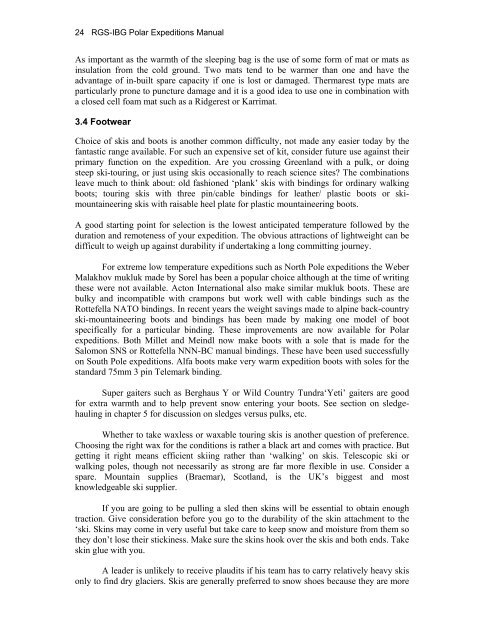Edited by Rachel Duncan 4th Edition ISBN 0-907649-91-2 London ...
Edited by Rachel Duncan 4th Edition ISBN 0-907649-91-2 London ...
Edited by Rachel Duncan 4th Edition ISBN 0-907649-91-2 London ...
Create successful ePaper yourself
Turn your PDF publications into a flip-book with our unique Google optimized e-Paper software.
24 RGS-IBG Polar Expeditions Manual<br />
As important as the warmth of the sleeping bag is the use of some form of mat or mats as<br />
insulation from the cold ground. Two mats tend to be warmer than one and have the<br />
advantage of in-built spare capacity if one is lost or damaged. Thermarest type mats are<br />
particularly prone to puncture damage and it is a good idea to use one in combination with<br />
a closed cell foam mat such as a Ridgerest or Karrimat.<br />
3.4 Footwear<br />
Choice of skis and boots is another common difficulty, not made any easier today <strong>by</strong> the<br />
fantastic range available. For such an expensive set of kit, consider future use against their<br />
primary function on the expedition. Are you crossing Greenland with a pulk, or doing<br />
steep ski-touring, or just using skis occasionally to reach science sites? The combinations<br />
leave much to think about: old fashioned ‘plank’ skis with bindings for ordinary walking<br />
boots; touring skis with three pin/cable bindings for leather/ plastic boots or skimountaineering<br />
skis with raisable heel plate for plastic mountaineering boots.<br />
A good starting point for selection is the lowest anticipated temperature followed <strong>by</strong> the<br />
duration and remoteness of your expedition. The obvious attractions of lightweight can be<br />
difficult to weigh up against durability if undertaking a long committing journey.<br />
For extreme low temperature expeditions such as North Pole expeditions the Weber<br />
Malakhov mukluk made <strong>by</strong> Sorel has been a popular choice although at the time of writing<br />
these were not available. Acton International also make similar mukluk boots. These are<br />
bulky and incompatible with crampons but work well with cable bindings such as the<br />
Rottefella NATO bindings. In recent years the weight savings made to alpine back-country<br />
ski-mountaineering boots and bindings has been made <strong>by</strong> making one model of boot<br />
specifically for a particular binding. These improvements are now available for Polar<br />
expeditions. Both Millet and Meindl now make boots with a sole that is made for the<br />
Salomon SNS or Rottefella NNN-BC manual bindings. These have been used successfully<br />
on South Pole expeditions. Alfa boots make very warm expedition boots with soles for the<br />
standard 75mm 3 pin Telemark binding.<br />
Super gaiters such as Berghaus Y or Wild Country Tundra‘Yeti’ gaiters are good<br />
for extra warmth and to help prevent snow entering your boots. See section on sledgehauling<br />
in chapter 5 for discussion on sledges versus pulks, etc.<br />
Whether to take waxless or waxable touring skis is another question of preference.<br />
Choosing the right wax for the conditions is rather a black art and comes with practice. But<br />
getting it right means efficient skiing rather than ‘walking’ on skis. Telescopic ski or<br />
walking poles, though not necessarily as strong are far more flexible in use. Consider a<br />
spare. Mountain supplies (Braemar), Scotland, is the UK’s biggest and most<br />
knowledgeable ski supplier.<br />
If you are going to be pulling a sled then skins will be essential to obtain enough<br />
traction. Give consideration before you go to the durability of the skin attachment to the<br />
‘ski. Skins may come in very useful but take care to keep snow and moisture from them so<br />
they don’t lose their stickiness. Make sure the skins hook over the skis and both ends. Take<br />
skin glue with you.<br />
A leader is unlikely to receive plaudits if his team has to carry relatively heavy skis<br />
only to find dry glaciers. Skis are generally preferred to snow shoes because they are more

















